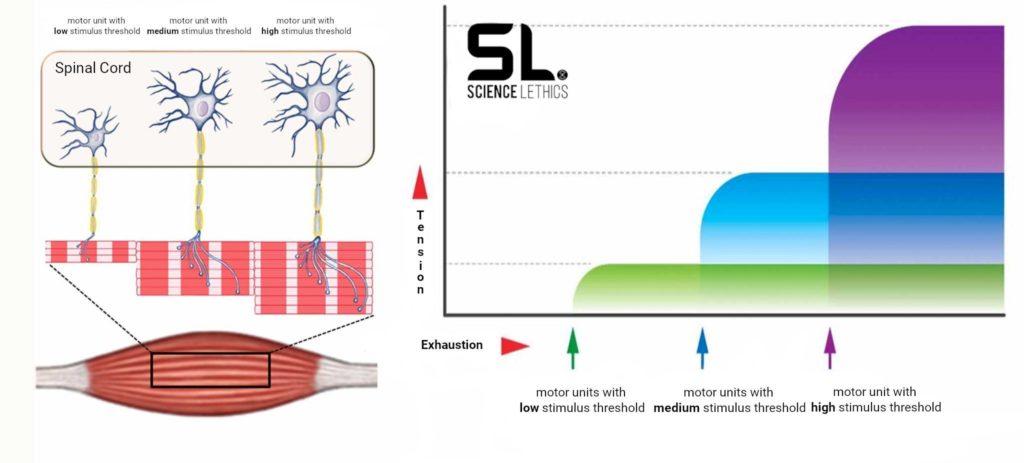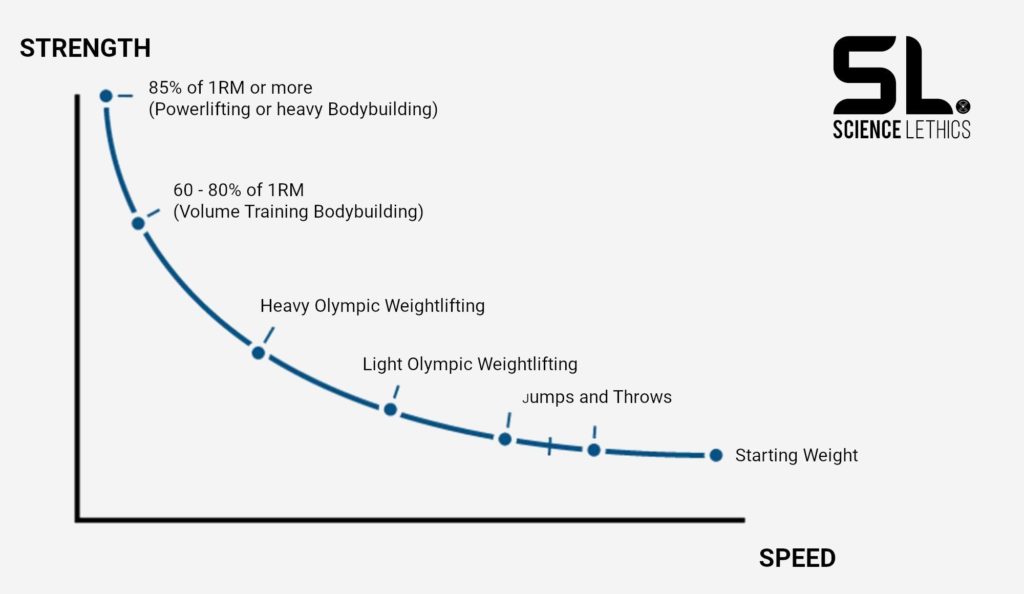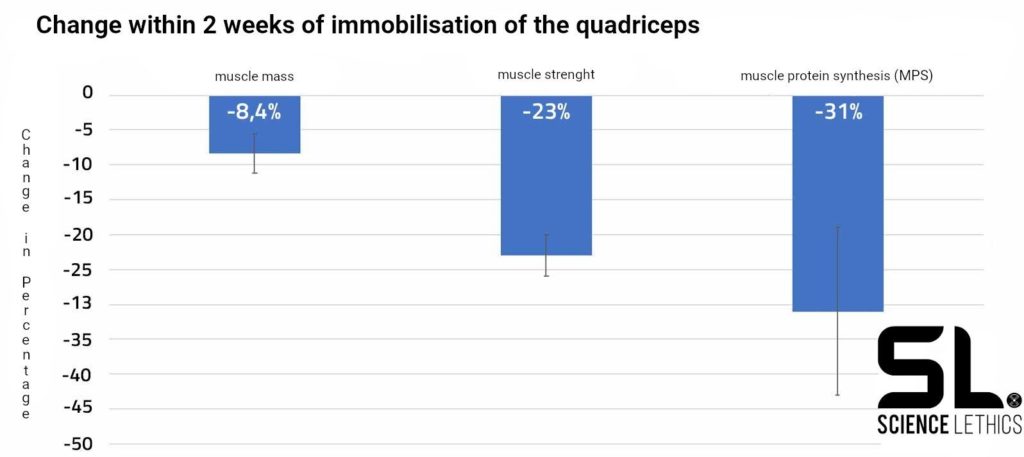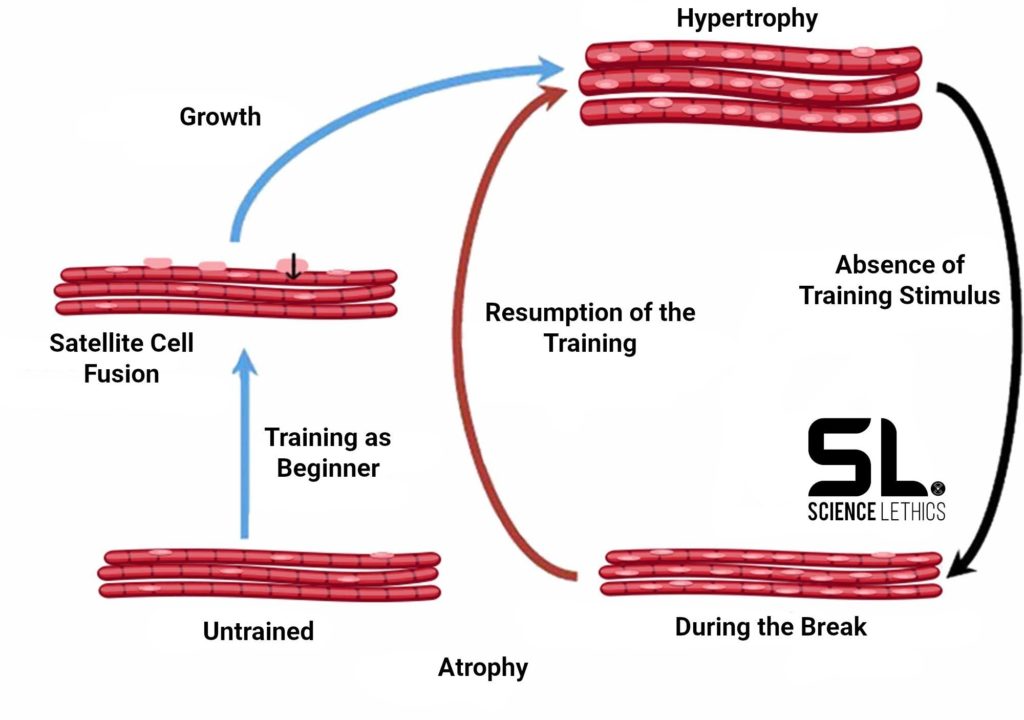The reasons an experienced athlete takes a complete break from training can vary. Whether it be an injury, a vacation, gym closures during lockdown, a personal commitment, or a mental break. Many things can happen over the course of a long training career. In other professional sports, it is just as perfectly normal to temporarily shift down a gear to give the body a recovery period, and many bodybuilders and strength athletes could possibly benefit from this as well. Accordingly, the abstinence from a training stimulus can be short or long. We therefore dedicate ourselves today to the question of how quickly muscle loss can take place during a training break.
Most people start training because they want to look better with the help of more muscle mass. For many, a kind of addiction creeps in during this process, causing them to worry a lot about their hard-earned muscle mass as soon as they are temporarily unable to go to training for a certain reason. The fear of muscle loss during a break in training is so great that some can barely go two days in a row without moving weights. The question is, do we really need to drive ourselves so crazy?
What happens when we take a break from training?
When we stop training with weights, a loss of maximal strength and muscle mass takes place; there is no question about that. However, the rate at which this loss occurs changes over time. In the first few days after our last strength training session, we initially experience a slight increase in maximum strength as the muscle damage caused in the last session is repaired and the associated central nervous system fatigue decreases. This is also one of the main reasons why strength athletes cut back on their training load in the last few days before a competition in order to be able to show their maximum performance on the deadline.
The theory behind this goes back to the so-called fitness-fatigue model [1]. It states that performance at any point is a function from previous adaptations leading to a state of fitness and fatigue. These influence our ability to perform. An athlete wants to perform at the highest possible level at a competition, so he must temporarily reduce fatigue to a minimum to maximize performance on race day. At the same time, he must prevent losing the adaptations he has built up through the previous training block. The model makes a lot of sense from the perspective of what we know today about adaptations to a training stimulus and fatigue.

In the days following this positive adaptation due to the absence of fatigue, there may be a slight loss of maximal strength that occurs because of the loss of coordination and possible lack of recruitment of motor units. Over the next four weeks or so, in addition to this, increasing losses of maximal strength occur due to loss of muscle-fiber volume in length and girth [2, 3]. Subsequently, however, muscle mass stabilizes and any further decline in maximal force is then due to the continued decline in motor unit recruitment [3].
In contrast to maximal strength, most of the muscle loss during a training pause appears to occur in the first month after the last stimulating session and only slightly thereafter. Indeed, noticeable losses in muscle fiber volume occur during the first four weeks or so, but the rate of degradation slows significantly after this phase [2, 3, 4, 5].
Why does muscle breakdown occur during a training break?
Muscles are made up of many tens of thousands of muscle fibers that bundle together to form a few hundred motor units. These in turn are recruited by our central nervous system in a strict order according to your stimulus threshold to perform movements. Motor units with a low stimulus threshold are always recruited first, and as the intensity of the load or exhaustion increases, the units with a higher stimulus threshold are added. The motor units with a low stimulus threshold remain activated even when motor units with a higher stimulus threshold are added.

It is important to note that the number of muscle fibers controlled by each motor unit increases as the stimulus threshold increases, and thus the number of muscle fibers involved increases exponentially as each new motor unit is switched on [6]. Low stimulus threshold motor units control only a few dozen muscle fibers, whereas high stimulus threshold motor units can involve tens of thousands of muscle fibers.
Motor units are activated in response to the level of effort we invest in a movement [7]. When we exert maximal effort, whether to move an extremely heavy weight, throw an object as fast as possible, or complete the last repetitions of a very tiring training set, we thereby recruit the high stimulus threshold motor units [8, 9, 10].
When an exercise involves a slow rate of muscle fiber contraction due to high loads or increasing fatigue, the muscle fibers of a high stimulus threshold motor unit also experience a high degree of mechanical loading because of the force-velocity relationship [11]. This mechanical stress leads to an increase in the rate of muscle protein synthesis over a period of approximately 48 hours [12].

Thus, when we exercise regularly, we generate a mechanical load on the motor units with a high stimulus threshold week after week. The mechanical load, in turn, is considered the greatest driver of muscle growth, and the motor units regulate the very muscle fibers that have the greatest potential for hypertrophy [13]. Then, when we stop exercising, the regular stimulus on these muscle fibers is absent and they start to degrade.
Each muscle fiber decreases in volume if it is not exposed to a sufficient degree of mechanical stress[14]. However, since the muscle fibers of the motor units with low stimulus thresholds are activated by very low levels of exertion, such as simply keeping the body upright, walking, or other everyday activities, they are not affected by muscle breakdown during a break in exercise. At least as long as the reason for the break is not a serious accident that causes us to become paralyzed or fall into a coma.
The fact that muscle fibers need a regular mechanical load to be maintained is also the reason why muscle breakdown is such a big problem for astronauts who stay on the International Space Station (ISS) for a long time [15, 16]. Because of weightlessness, astronauts do not have to exert force to fight Earth’s gravity. Instead, they float around, which means that their high and low threshold motor units do not experience any mechanical stimulus as long as they do not move any other object or push themselves off the inner walls to get from one part of the satellite to the other. The ubiquitous absence of mechanical stress would lead to rapid and severe muscle degradation if spacewalkers did not perform specialized strength training. This also explains why muscle degradation during a training break is particularly rapid in the first weeks after the last training session and then stabilizes. The large and numerous muscle fibers activated by motor units with a high stimulus threshold lose their regular stimulus and therefore degrade more quickly, whereas muscle fibers activated by motor units with a lower stimulus threshold are usually still loaded by everyday activities.
Thus, the degree to which we experience muscle breakdown during a break from exercise depends on the type of other physical activities that the individual performs. A person who generally leads an active lifestyle or engages in physically demanding occupational activities will therefore experience less loss of muscle mass than someone who is otherwise inactive, is confined to bed rest due to injury, or whose limbs are prevented from moving with the aid of a cast or splint.

In studies, total limb immobilization resulted in an immediate reduction in muscle protein synthesis MPS [17]. Since the rate of muscle protein breakdown is not reduced to the same extent, rapid loss of muscle fiber protein occurs. When muscles are not exercised, in this case due to injury, their mass decreases by approximately 0.5 percent per day, with the rate decreasing the most during the first two weeks of inactivity [18].
Why does muscle breakdown occur during a training break?
When we exercise and our muscles grow, the number of nuclei in muscle fiber increases because each nucleus can only control a certain area within a fiber. The reason for this is that so-called satellite cells fuse with the muscle fiber and give up their nucleus to it. Then, when we temporarily stop exercising, the muscles shrink, but the number of nuclei remains unchanged for a long time [19, 20].
When we build muscle mass and strength after returning to exercise, this typically occurs more rapidly than when they were originally built [21, 22].
This occurs for two reasons: First, the reduction in muscle fibers volume does not affect the number of nuclei within the muscle fibers [20]. Therefore, atrophy due to the absence of habitual strength training does not affect our maximal capacity to achieve a given rate of MPS. It only changes our current rate. Consequently, if we re-expose a fibers to a mechanical load in the future, it can achieve the same rate of MPS that it had before and therefore rebuild the lost mass very quickly.

What are the disadvantages of training breaks?
So far, we have learned that muscle degradation during a training break is particularly rapid in the first four weeks and slows down considerably thereafter. We have also learned that when training resumes, the degraded muscles rebuild much faster than they did originally. In the long run, taking a break from training seems to be half as bad for our gains as many believe.
Every now and then, it may even be necessary to take some time off from training to allow the central nervous system to reduce fatigue. While a period of reduced training volume is better suited for this, as more muscle mass is preserved at the same time, many athletes find a complete break more comfortable than training at half throttle.
Until recently, it was assumed that a break in training had no significant disadvantages. However, recent research has observed that repeated periods of load and unload can cause connective tissue to accumulate in the muscles, which could make them stiffer and more susceptible to injury [20]. If one wishes to unload one’s central nervous system and can choose between a period of reduced training volume or a complete break from training, continuing to train at a lower workload is probably the wiser solution.
What are the disadvantages of training breaks?
Muscle loss during a training break is initially very rapid. Within the first four weeks
or so after the last stimulating training session, the volume of muscle fibres
decreases. These fibres do not experience sufficient mechanical load due to the
remaining exercise in everyday life and are therefore not recruited to a sufficient
extent. However, when we resume training after the break, the rebuilding of the lost
muscle mass takes place much faster than it did originally. Therefore, muscle loss
during a break in training seems to be less of a problem than most of us fear.
Possibly the most important tool to recover your gains?
Do you already know our specially designed COMEBACK FITYEAR 2021 Training Programs? 4 dedicated program guides for beginner, as well as intermediate to advanced trainees, who want to become physical active again – at home or at the gym- after a layoff period. We wrote the COMEBACK FITYEAR 2021 Programs, so you can get back in shape – after a break, especially during those pandemic lockdown times. In the comfort of your own home, your own home gym or a commercial fitness club – we got you covered: from solely bodyweight based exercises to simple workout
equipment like dumbbells and resistance bands up to a proper gym setup: this is exactly what you need to get a great and effective workout again, while still being able to progress and build muscle!
We are looking forward to your visit on our website. Click here and learn more now.
Primary Source: Chris Beardsley: “How does taking a break from strength training affect
hypertrophy?”, https://medium.com/@SandCResearch
References
- Chiu, Loren ZF, and Jacque L. Barnes. “The fitness-fatigue model revisited: Implications for planning short-and long-term training.” Strength & Conditioning Journal 25.6 (2003): 42-51.
- Kubo, Keitaro, et al. “Time course of changes in the human Achilles tendon properties and metabolism during training and detraining in vivo.” European journal of applied
physiology 112.7 (2012): 2679-2691. - Kubo, Keitaro, et al. “Time course of changes in muscle and tendon properties during strength training and detraining.” The Journal of Strength & Conditioning Research 24.2 (2010): 322-331.
- Hortobágyi, T. I. B. O. R., et al. “The effects of detraining on power athletes.” Medicine &
Science in Sports & Exercise 25.8 (1993): 929-935. - McMahon, Gerard E., et al. “Impact of range of motion during ecologically valid resistance training protocols on muscle size, subcutaneous fat, and strength.” The Journal of Strength & Conditioning Research 28.1 (2014): 245-255.
- Enoka, Roger M., and Andrew J. Fuglevand. “Motor unit physiology: some unresolved
issues.” Muscle & Nerve: Official Journal of the American Association of Electrodiagnostic Medicine 24.1 (2001): 4-17. - De Morree, Helma M., Christoph Klein, and Samuele M. Marcora. “Perception of effort reflects central motor command during movement execution.” Psychophysiology 49.9 (2012): 1242- 1253.
- Kukulka, Carl G., and H. Peter Clamann. “Comparison of the recruitment and discharge
properties of motor units in human brachial biceps and adductor pollicis during isometric contractions.” Brain research 219.1 (1981): 45-55. - Desmedt, Jean Edouard, and Emile Godaux. “Ballistic contractions in man: characteristic
recruitment pattern of single motor units of the tibialis anterior muscle.” The Journal of
physiology 264.3 (1977): 673-693. - Adam, Alexander, and Carlo J. De Luca. “Recruitment order of motor units in human vastus lateralis muscle is maintained during fatiguing contractions.” Journal of neurophysiology 90.5 (2003): 2919-2927.
- Piazzesi, Gabriella, et al. “Skeletal muscle performance determined by modulation of number of myosin motors rather than motor force or stroke size.” Cell 131.4 (2007): 784-795.
- Damas, Felipe, et al. “A review of resistance training-induced changes in skeletal muscle
protein synthesis and their contribution to hypertrophy.” Sports medicine 45.6 (2015): 801-807. - Wackerhage, Henning, et al. “Stimuli and sensors that initiate skeletal muscle hypertrophy following resistance exercise.” Journal of Applied Physiology 126.1 (2019): 30-43.
- Wisdom, K. M., S. L. Delp, and E. Kuhl. “Review. Use it or lose it: Multiscale skeletal muscle adaptation to mechanical stimuli.” Biomech Mod Mechanobio. available online first. http://dx.doi. org/10.1007/s10237-014-0607-3 (2014).
- Gopalakrishnan, Raghavan, et al. “Muscle volume, strength, endurance, and exercise loads during 6-month missions in space.” Aviation, space, and environmental medicine 81.2 (2010): 91-104.
- Trappe, Scott, et al. “Exercise in space: human skeletal muscle after 6 months aboard the International Space Station.” Journal of applied physiology (2009).
- Wall, Benjamin T., et al. “Disuse impairs the muscle protein synthetic response to protein ingestion in healthy men.” The Journal of Clinical Endocrinology & Metabolism 98.12 (2013): 4872-4881.
- Wall, Benjamin T., Marlou L. Dirks, and Luc JC Van Loon. “Skeletal muscle atrophy during short-term disuse: implications for age-related sarcopenia.” Ageing research reviews 12.4 (2013): 898-906.
- Kubo, Keitaro, et al. “Time course of changes in muscle and tendon properties during strength training and detraining.” The Journal of Strength & Conditioning Research 24.2 (2010): 322-331.
- Schwartz, Lawrence M. “Skeletal Muscles Do Not Undergo Apoptosis During Either Atrophy or Programmed Cell Death-Revisiting the Myonuclear Domain Hypothesis.” Frontiers in Physiology 9 (2019): 1887
- Ogasawara, Riki, et al. “Comparison of muscle hypertrophy following 6-month of continuous and periodic strength training.” European journal of applied physiology 113.4 (2013): 975-985.
- Ogasawara, Riki, et al. “Effects of periodic and continued resistance training on muscle CSA and strength in previously untrained men.” Clinical physiology and functional imaging 31.5 (2011): 399-404.
- Shimkus, Kevin L., et al. “Responses of skeletal muscle size and anabolism are reproducible with multiple periods of unloading/reloading.” Journal of Applied Physiology 125.5 (2018): 1456-1467.
